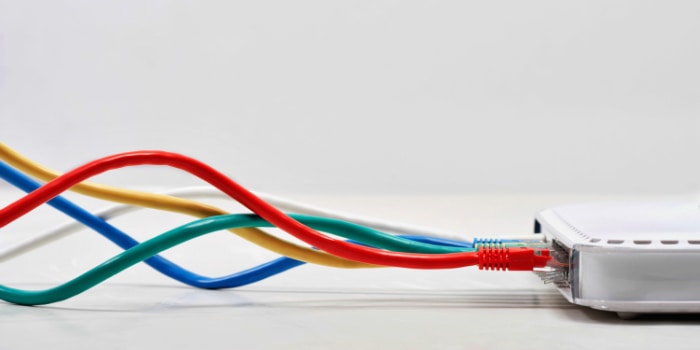Cat6 vs. Cat6a: Evaluating Speed, Performance, and Cost

Reliable and fast internet connectivity has become an essential aspect of both personal and professional environments. Central to this connectivity are Ethernet cables, the silent workhorses that keep our digital world smoothly running.
Cat6 and Cat6a cables, in particular, represent the forefront of this technology, offering substantial improvements in network performance and speed.
Understanding Cat6 Cables
Cat6 cables represent a significant step forward in network cabling technology. Known for their enhanced performance over previous iterations, these cables have become a standard choice in various networking environments.
Construction and Features
Cat6 cables are designed with four twisted pairs of copper wire, a structure that significantly reduces crosstalk and interference compared to older cable versions. They are also equipped with a more stringent specification for system noise and crosstalk.
The enhanced shielding in some Cat6 cables further improves their resistance to external interference, making them a robust choice for environments with a high level of electromagnetic interference.
Bandwidth and Performance
One of the most notable characteristics of Cat6 cables is their bandwidth capacity, which reaches up to 250 MHz. This is double the bandwidth of Cat5e, the previous Ethernet cable standard.
The increased bandwidth allows for higher data transfer rates, making Cat6 cables well-suited for applications requiring high-speed data transfer, such as video streaming, online gaming, and server applications.
Speed and Distance
Cat6 cables can transmit data at speeds up to 10 Gbps over a limited distance. The optimal performance is guaranteed up to a length of 55 meters, beyond which the speed might reduce to 1 Gbps.
This feature makes Cat6 an excellent choice for small to medium-sized networks where high-speed data transmission is essential but the total cable length doesn’t exceed the 55-meter mark.
Applications and Use Cases
These cables are commonly used in settings where higher bandwidth and better data transmission rates are required. They are ideal for office networks, data centers, and residential installations where multiple devices are connected, and high-speed internet is a necessity.
Their ability to handle more significant amounts of data at higher speeds makes them a practical choice for modern, data-intensive applications.
Cat6 cables, with their advanced capabilities, offer a considerable improvement over their predecessors, making them a reliable option for both current and future networking requirements. Their balance of speed, bandwidth, and interference resistance positions them as a versatile solution in the world of Ethernet cabling.
Exploring Cat6a Cables
Cat6a cables are an evolution of the Cat6 standard, offering enhanced performance and reliability for even the most demanding network environments. They are designed to meet the needs of modern networks, providing higher bandwidth and better signal integrity over longer distances.
Advanced Construction and Features
Cat6a stands for Category 6 augmented and is an advancement in cable technology. These cables are constructed with thicker copper wires and often include a spline to reduce crosstalk.
The additional shielding in Cat6a cables, either around individual wire pairs or the cable as a whole, provides superior immunity to electromagnetic interference. This robust construction allows for more reliable data transmission, especially in environments with high levels of interference.
Enhanced Bandwidth and Performance
A key improvement in Cat6a cables is their bandwidth capacity, which is double that of Cat6, reaching up to 500 MHz. This increased bandwidth enables higher data transfer rates, making Cat6a an excellent choice for applications that demand high-speed data transmission over longer distances.
They are especially well-suited for environments where both speed and signal quality are paramount.
Speed and Distance Capabilities
Cat6a cables can effectively support data transmission speeds of up to 10 Gbps, similar to Cat6, but over longer distances of up to 100 meters. This extended reach without signal degradation makes Cat6a cables ideal for large-scale installations such as enterprise-level data centers and extensive office networks.
Their ability to maintain high-speed connections over greater distances offers significant flexibility in network design and implementation.
Optimal Use Cases
Given their enhanced capabilities, Cat6a cables find their use in high-performance networks where bandwidth and distance are critical factors. They are a preferred choice in advanced networking environments, such as in server farms, data centers, and large corporate setups.
The robustness and reliability of Cat6a also make them suitable for industrial applications where cable performance cannot be compromised.
Cat6a cables, with their improved specifications and performance, represent the cutting edge in Ethernet technology. They provide a future-proof solution for networks that require high-speed data transfer over extended distances, ensuring that they can handle the increasing data demands of modern applications.
Physical Differences

The physical attributes of Cat6 and Cat6a cables are as crucial as their technical specifications in determining their suitability for various applications. These differences not only influence their performance but also impact their installation and handling.
Cable Thickness
One of the most noticeable differences is in cable thickness. Cat6a cables are generally thicker than Cat6.
This is primarily due to the enhanced shielding in Cat6a cables, which adds to their overall diameter. The thicker design of Cat6a helps in reducing crosstalk and interference more effectively but also means they require more space for installation and may not be as flexible as Cat6 cables.
Sheathing and Flexibility
The sheathing of Cat6a cables is also more robust compared to Cat6. This sturdier construction is necessary to support the augmented shielding and maintain signal integrity over longer distances. However, this also results in reduced flexibility.
In contrast, Cat6 cables, being thinner and less heavily shielded, offer more flexibility, making them easier to handle and install in tighter spaces.
Installation Considerations
Due to their thicker and stiffer nature, Cat6a cables may pose some challenges during installation, especially in constrained spaces or where many bends are required. They may also require larger cable trays and more room in conduits.
On the other hand, Cat6 cables, with their more pliable nature, are easier to manage in various installation scenarios, including residential and small office environments.
Cable Management and Deployment
When it comes to cable management and deployment, the physical characteristics of these cables play a significant role. The bulkier Cat6a cables can be more challenging to manage, especially in dense network infrastructures.
In contrast, Cat6 cables, being more slender and flexible, are generally easier to route and organize, especially in smaller-scale installations.
Performance Metrics
Evaluating the performance of Cat6 and Cat6a cables involves scrutinizing several key metrics. These metrics not only define the capabilities of each cable type but also help in determining their suitability for different networking needs.
Data Transfer Speed
Data transfer speed is a critical metric for network cables. Both Cat6 and Cat6a are capable of supporting speeds up to 10 Gbps.
However, the distance over which these speeds can be maintained varies. Cat6 cables can achieve 10 Gbps over distances up to 55 meters, whereas Cat6a cables can maintain these speeds up to 100 meters.
This extended reach of Cat6a makes it a more suitable option for larger networks requiring high-speed data transmission over longer distances.
Bandwidth Capacity
Bandwidth capacity is another vital performance metric. Cat6 cables offer a bandwidth of up to 250 MHz, which is sufficient for many current applications.
In contrast, Cat6a cables double this capacity to 500 MHz, allowing for greater data throughput and supporting more intensive use, such as in data centers or for high-definition video streaming.
Signal Interference and Crosstalk
Crosstalk, the interference between different signal paths, is a significant concern in network cabling. Cat6 cables include improvements over previous generations to reduce crosstalk, but Cat6a cables take this a step further.
The enhanced shielding in Cat6a significantly reduces crosstalk and external interference, leading to better signal integrity and overall network performance.
Signal Integrity Over Distance
While both cable types maintain signal integrity, the way they handle this over distance differs. Cat6a’s improved shielding and construction enable it to maintain higher quality signals over longer distances compared to Cat6.
This aspect is particularly important in large-scale installations where cable runs are extensive.
Suitability for Various Network Demands
The choice between Cat6 and Cat6a cables often comes down to the specific demands of the network. Cat6 cables are well-suited for smaller networks where high-speed data transfer is required but over shorter distances.
In contrast, Cat6a cables are ideal for larger networks with more intensive data transfer needs and longer cable runs.
Cost Implications
When selecting network cables, cost is a key factor alongside technical specifications. Understanding the cost implications of Cat6 and Cat6a cables is essential for making an informed decision that balances budget constraints with networking needs.
Initial Purchase Price
Generally, Cat6a cables are more expensive than Cat6 cables. This price difference is attributed to the more advanced construction of Cat6a, including thicker copper wires and additional shielding.
The manufacturing process for Cat6a is more complex, contributing to its higher cost.
Installation and Labor Costs
The thicker and less flexible nature of Cat6a cables can lead to higher installation costs. They may require more time and effort to install, especially in tight spaces or complex network setups.
In contrast, the more pliable Cat6 cables can be easier and thus less costly to install in certain environments.
Cost-Effectiveness Relative to Performance
While Cat6a cables are more expensive, their enhanced performance characteristics, such as higher bandwidth and better signal integrity over longer distances, offer greater value in certain scenarios. For networks that require these advanced features, investing in Cat6a could be more cost-effective in the long run.
Long-Term Investment Considerations
When considering the long-term implications, Cat6a cables could be a more prudent investment. Their superior performance and capacity to handle future network upgrades can reduce the need for frequent cable replacements.
This future-proofing aspect of Cat6a cables can lead to savings over time, despite the higher initial cost.
Balancing Cost with Network Requirements
Choosing between Cat6 and Cat6a cables involves weighing their cost against your network’s specific requirements. For small-scale or less demanding networks, the lower cost of Cat6 might be more appealing.
However, for larger, more data-intensive networks, the initial higher investment in Cat6a cables could provide better performance and longer-term savings.
Conclusion
Selecting the right Ethernet cable, be it Cat6 or Cat6a, is crucial for the efficiency and reliability of any network. Cat6 cables, with their balance of speed, flexibility, and cost-effectiveness, are well-suited for small to medium-sized networks.
They offer a significant improvement over older standards and are capable of supporting most modern networking needs. On the other hand, Cat6a cables, with their higher bandwidth, enhanced performance over longer distances, and superior resistance to crosstalk and interference, are ideal for more demanding network environments.
These include large-scale business networks and data-intensive applications.
Cost is a key consideration, and the choice between these cables often depends on budget constraints and long-term networking requirements. While Cat6a cables come with a higher initial price, their advanced features and durability may offer better value over time, especially in environments where network demands are high and continuously evolving.
Factors like the required data transfer speed, network size, distance, interference levels, and budget all play critical roles. By carefully considering these aspects, network administrators and users can ensure they choose a cable that not only meets their current needs but is also capable of adapting to future technological advancements and network expansions.
This thoughtful selection process ensures a robust and efficient network, capable of supporting both today’s and tomorrow’s digital demands.



